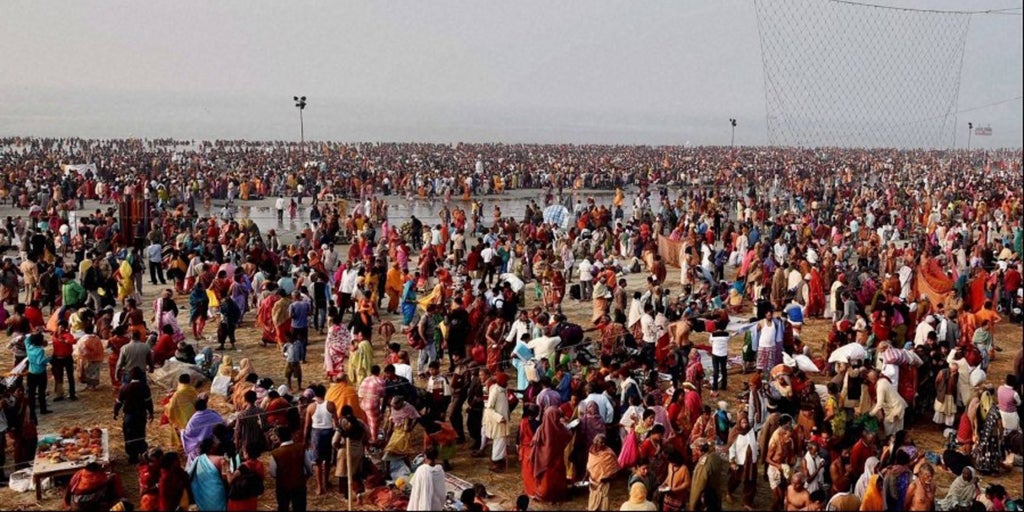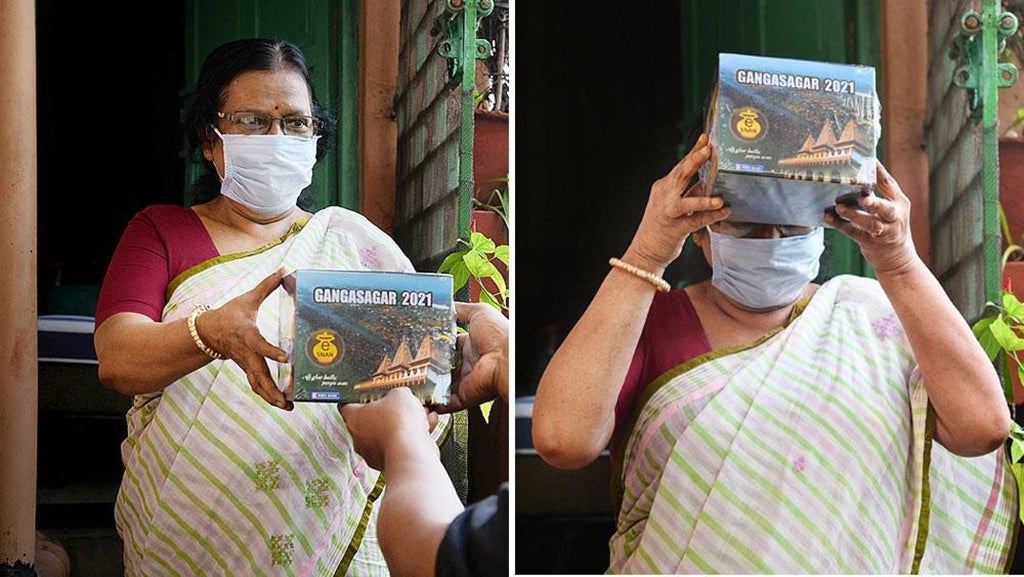Fractured Fluidity, Reified Ritual: E-snan and Changing Dynamics of Makar-snan during COVID-19
contributed by Nabanita Samanta, 13 April 2021
Introduction
As the plaguing pandemic of COVID-19 swept the world, the months-long hiatus brought by lockdowns and ‘physical distancing’ has left dramatic impacts on every walk of life including the realm of religious practices. With several of the religious meanings being re-negotiated and ritual praxis being altered in light of the frightening fragility and overwhelming uncertainties, ritual innovations appearing in the guise of the ‘new normal’ need careful delineation. It is with this view in mind that I seek to analyze, within the limited scope of this brief exploration, the changing dynamics of makar-snan. Makar-snan refers to the ritual practice of taking a holy dip on the auspicious occasion of ‘Makar-Sankranti’ as it is popularly observed in the Indian subcontinent. As I fix my analytical gaze from hydro-social (Linton 2006, Linton and Budds 2014, Swyngedouw 2009, Mukherjee 2018) vantage point while deciphering the religious significance, this essay will mostly concentrate on the ritual innovation of ‘e-snan’ as a re-mediated form of hydro-sacred relation and its repercussions on hydrosociality.

Figure 1: A naga-sadhu at the holy site of Gangasagar readying for taking a ritual dip (Source: official website of district administration of Sagardwip)
Hydro-sacred and Hydro-social
Water is as much a necessary precondition for life as it is for opening up the possibilities for merging our constricted individuality into the wider strand of the universal. The mystery and might of water lies embedded in its elemental materiality which coalesces with the rich existential symbolism entailed in the ‘elixir of life’ (i.e. water). Thus, the indispensability of water stretches beyond mere survival needs to feed the aspirations for transcendence.
While the symbolic potential of water gets manifested in myriad forms varying with specific historical and cultural relations, the widespread sacredness attributed to this intractable fluid can be ascertained from its almost ubiquitous presence in varied rituals across religious traditions. The ritual of makar-snan is one such practice which exemplifies this hydro-sacred relation. Furthermore, the hydro-scared relation encapsulated in the ritual praxis of makar-snan needs to be understood as a culturally rich form of hydro-sociality. While taking a dip in the holy river Ganga (the Ganges) has been accorded with much sacredness in the discourses and practices of Hinduism, a dip in the holy water is considered more sacred at particular places and during some particular tithis (specific period of time). Poush Sankranti (the last day of the Bengali month ‘Poush’), or also known as Makar Sankranti (as the day marks the Sun’s transit into the Makara rashi) is one such significant tithi which has been considered as having special religious significance, and taking a holy dip on this particular occasion has long remained a popular ritual among many Hindu devotees.
Though makar-snan or the practice of taking a dip on the auspicious tithi of Makar Sankranti is performed in different sites across the river bank, it is Gangasagar (i.e. the place of confluence where the river Ganga merges with the Bay of Bengal) which is considered the most sought-after destination for the devotees to access the divine grace in the most profound way. This drives an overwhelming number of pilgrims from across the length and breadth of the Indian subcontinent to congregate at the holy site of Gangasagar to perform the pious makar-snan.
‘Sab tirtha bar bar, Gangasagar ek bar’
The ritual of makar-snan is considered conducive for eliminating accumulated sins. This belief can be traced back to the puranic narrative depicting how the river Ganga was brought to the earth by the sincere resolve of Bhagiratha to free his ancestors from the curse of sage Kapila.
As per the narrative, former King Sagara decided to perform ‘Ashvamedha Yagna’ (a royal rite of horse-sacrifice to preach imperial sovereignty over the territory traversed by the wandering horse which is to be sacrificed) to extend his royal authority. In order to curb the incessant power of King Sagara, Indra stole the sacrificial horse and kept it hidden in Kapila’s hermitage situated in the place which later came to be known as Gangasagar. When the sixty thousand sons of Sagara were sent in search of the lost horse, they spotted the horse hidden in the hermitage and accused sage Kapila of stealing the horse. Kapila, being furious with such false allegations, turned Sagara’s sons into ashes. Later, as Bhagiratha, the great grandson of Sagara, persuaded sage Kapila to redeem the souls of his deceased ancestors, Kapila advised Bhagiratha to bring the river Ganga from heaven to flow over the ashes of his ancestors. It was due to the resolute tapasya (yogic penances and austerities) of Bhagiratha that the river Ganga was descended on the earth; and as the holy water touched the mortal remains of Sagara’s sons, they attained liberation. It is believed that Makar-Sankranti marks the day when the Ganga descended on the earth aiding the salvation of Sagara’s sons. Adhering to the mythic significance of this puranic narrative, the sanctity of Gangasagar surpasses all other pilgrimages in terms of ritual piety as it is evident from the commonplace Bengali saying: ‘sab tirtha bar bar, Gangasagar ek bar’ (while one may visit other holy places several times, visiting Gangasagar just once in life is enough for salvation). This makes annual gathering at Gangasagar on the occasion of Makar-Sankranti as the second largest religious congregation (the largest being the Kumbha Mela) in the world.

Figure 2: Large number of devotees taking the holy dip (makar-snan) at the sacred site of Gangasagar on Makar-Sankranti in 2020 (Source: The New Indian Express)
Ritual Innovation of ‘E-snan’
This year the outbreak of the COVID-19 pandemic and subsequent imposition of restrictions on travelling came as a major obstacle for the annual ritual practice of makar-snan. With the norms and regulations of physical distancing being in place, people were discouraged from physically travelling to Gangasagar to take a dip. Instead, the state government made arrangements for ‘e-snan’, a service of delivering the holy Ganga water to the doorsteps of people who placed an online order. Arrangements were also made to live-stream the Gangasagar Mela (e-darshan) so that people could be virtually present since they were discouraged from physically gathering at the holy site.

Figure 3: A devotee receiving the ‘e-snan’ kit at her doorstep (Source: Anandabazar Patrika)
Although the ritual innovation of ‘e-snan’ has helped in mediating the religious aspirations on one hand and concerns over health-safety on the other, it has brought some significant repercussions. While the plaguing pandemic has induced several upheavals in the realms of religious practices and ritual praxis, the altered dynamics of makar-snan stands as an exemplary case to demonstrate the cascading changes looming large in the realm of the hydro-sacred and the hydro-social.
Spatial Re-configuration, Fractured Fluidity
The shift from physically taking a dip to virtually witnessing the ritual and bathing in water delivered by an external agency to the doorstep of people entails a fundamental spatial re-configuration. With the site of ritual being shifted from the physical setting of the sacred geography to the domestic space which is extremely private in nature, the place-based religious framing of makar-snan stands altered with profound implications on the co-becoming of water and people.
In the process of a holy dip, water while acting as a solvent to wipe away the ‘sins’ acquires its sacredness from the way people relate to water; at the same time water mediates the process of bridging the two realms: the creaturely and the cosmic. Thus, the ritual of makar-snan accentuates the co-constitutive nature of water and people, of holiness (of water) and wholeness (which people strive towards). However, ‘e-snan’ as a new practice while resulting in (dis)-embodiment and de-sensorialization of makar-snan has left the dynamic fluidity severely fractured. Here, by ‘fluidity’ I point to two aspects simultaneously - elemental fluidity of water on one hand and the definitional fluidity of the ritual of makar-snan on the other hand.
From the Virtuous to the Virtual - ‘Hydreification’
On the precipices of fractured fluidity, the hydro-sacred-social complex losing its glory and grandeur runs into the risk of being reified. The sacredness of water when stripped off from its social nature and ecological embeddedness loses its potentiality as the ‘e-snan’ kit turns the complexity of water into an abstracted ‘commodity’ to be purchased online. In this process of ‘hydreification’, to borrow the term from Jamie Linton (2006), the relational and processual aspects of water get obscured under the ‘thing-ness’ of water (packaged in ‘e-snan’ kit) and aridity of the new ritual.

Figure 4: Online portal for ordering ‘e-snan’ kit (Source: screenshot from the official website of district administration of Sagardwip)
Concluding Remarks
Water when conceived at the confluence of social and hydrological dimensions entails dynamic, processual aspects which are simultaneously material and symbolic. In this vein of understanding, water-centric rituals such as the practice of makar-snan, much beyond their idiosyncrasies, are primarily meant for instilling the embodied awareness of the inexorable relationship between life and water. But the ritual innovation of ‘e-snan’ is likely to erode this sacred embodiment. If this re-mediated form of ritual emerging in the guise of ‘new normal’ continues (as some section of people may find it convenient) to outlive the span of the pandemic, the appropriation of water’s fluidity and reification of makar-snan may leave significant imprints on the hydro-sacred-social complex.
References cited:
- Linton, Jamie and Jessica Budds. (2014). ‘The hydro-social cycle: Defining and mobilizing a relational-dialectical approach to water’, Geoforum, 57: 170-180.
- Linton, Jamie. (2006). What is Water? The History and Crisis of a Modern Abstraction (PhD Thesis). Retrieved from CURVE (Carleton University Research Virtual Environment).
- Swyngedouw, Erik. (2009). ‘The Political Economy and Political Ecology of the Hydro-Social Cycle’, Journal of Contemporary Water Research & Education, 142(1): 56-60.
- Mukherjee, Jenia. (2018). ‘From Hydrology to Hydrosociality: Historiography of Waters in India’. In Jeremy L. Caradonna (Ed.), Routledge Handbook of the History of Sustainability, 254–272. London: Routledge.
Disclaimer: The views and opinions expressed in this article are those of the authors and do not necessarily reflect the position of the blog editorial team or the Asia Research Institute.
South Asia | Southeast Asia | East Asia | Other Places | Hinduism | Buddhism | Islam | Christianity | Other Religions
Nabanita Samanta is a graduate student pursuing Masters in Sociology at the University of Hyderabad, India. Her research interests include Political Ecology and Ecosophy, Hydro-social Relations and Water Governance, Nonviolent Resistance and Social Change, Decentralization and Local Governance. She can be contacted at nabanitasamanta097@gmail.com.

